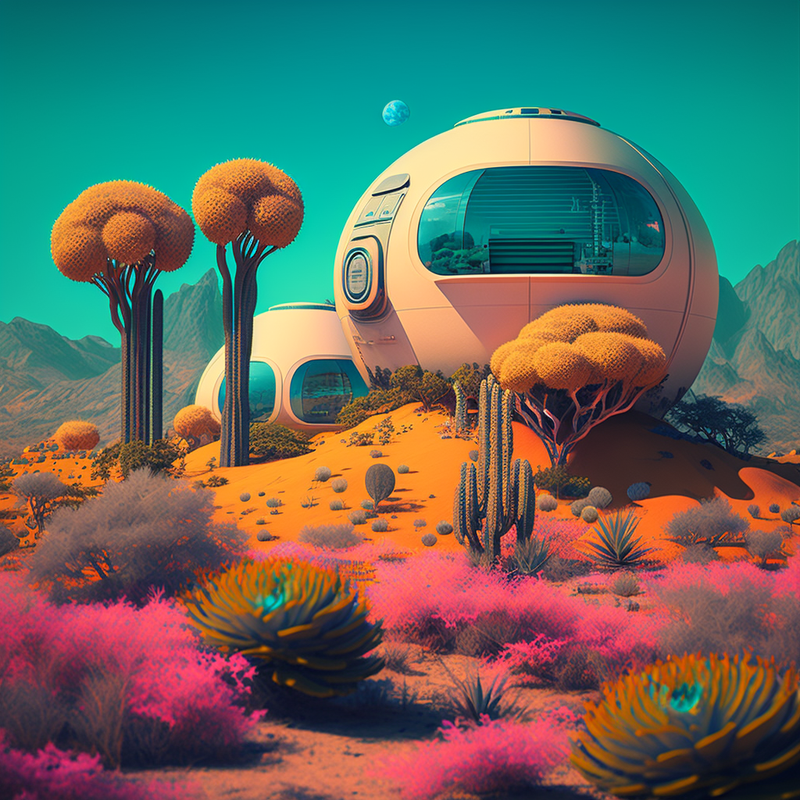The men and women of the spacefaring colony had finally arrived on a new planet, their hope for establishing a sustainable human presence amongst the stars. As they set out to begin creating a new home, they found that the planet was full of unique resources – from large deposits of rare minerals to plants and animals that seemed completely unfamiliar.
Using advanced technology, the settlers constructed retro-futuristic buildings with robots doing much of the heavy lifting. They also used innovative farming techniques and systems using hydroponics to produce fresh food in artificial environments, while minimizing energy requirements and waste.
The colonists created cities of gleaming metal spires which ran on renewable energy sources such as geothermal power plants, wind turbines and solar panels. Using these green technologies they were able to connect their buildings to self-sustaining and renewable energy systems.
As the colonies began to thrive, they made sure to preserve the wilder parts of the planet by establishing parks, reserves, and protected areas where native species could be studied and conserved. With their vision of a bright future restored, the colony looked forward with enthusiasm – both to a more sustainable home in an unknown world, as well as what opportunities lay ahead for them in a new universe.
retro-futuristicAs they slowly transformed the unknown planet, the settlers crafted distinctive retro-futuristic buildings. The s aesthetic. With advanced robotic machinery doing much of the heavy lifting, these structures could be quickly erected using a variety of materials and techniques such as pre-fabrication and automated construction. Sleek metal spires towered over newly established cities while amplifying natural energy sources like wind and solar power; transparent domes housed hydroponic gardens that brought vitality to otherwise barren landscapes; carbon neutral habitats were designed with sustainability in mind. Through careful planning and innovation, humanity successfully settled down into an unknown world – leaving behind its mark for generations to come.tyle of architecture combined elements of classic science fiction with modern technology to create a unique and otherworldly buildings that caught the eye of all.
A human colony on an unknown planet with retro futuristic buildings sounds like an interesting concept! Here are a few ideas on how such a colony might be designed and organized:
Retro Futuristic Buildings: The architecture of the colony could be inspired by classic science fiction, with buildings that have a "retro futuristic" aesthetic. This could include elements like streamlined shapes, chrome accents, and neon lighting. These buildings could be designed to be both functional and visually striking, creating a sense of wonder and excitement among the colonists.
Sustainability: Given that the colony would be located on an unknown planet, sustainability would be a crucial factor in its design. Buildings could be constructed using environmentally friendly materials and designed to be energy-efficient. Renewable energy sources like solar or wind power could be used to generate electricity, and water could be recycled and reused to minimize waste.
Community Spaces: To create a sense of community among the colonists, the colony could include public spaces such as parks, plazas, and community centers. These spaces could be designed to encourage interaction and collaboration, with features like outdoor seating, communal gardens, and recreational areas.
Transportation: Given that the colony would be located on an unknown planet, transportation would be a key consideration. The colony could be designed with a network of walkways, bike paths, and electric vehicles to facilitate easy movement between different areas. In addition, public transportation options like buses or shuttles could be provided to connect different parts of the colony.
Overall, a human colony on an unknown planet with retro futuristic buildings could be a fascinating setting for a science fiction story or game. By incorporating elements of sustainability, community, and efficient transportation, such a colony could be designed to be both functional and visually stunning.
